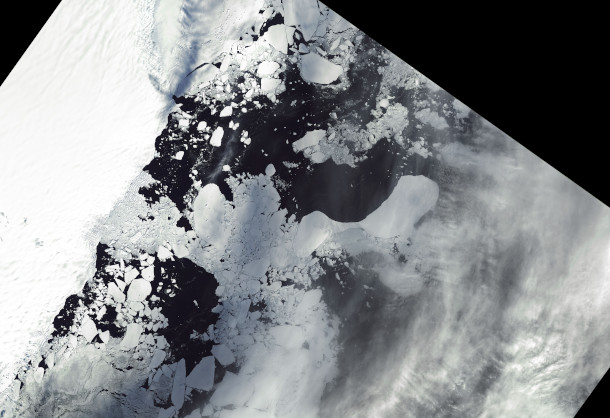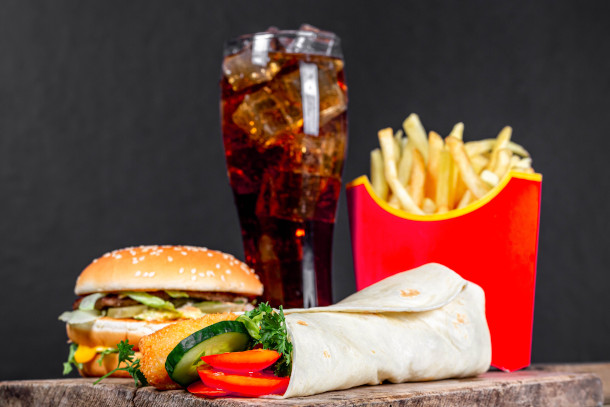Beyond the Headlines
Air Date: Week of April 1, 2022

East Antarctica is typically seen as very stable; the recent ice shelf break up is the first humans have ever observed in the half-century since satellites began to imaging Antarctica. (Photo: NASA, Public Domain)
On this week’s trip beyond the headlines, Host Steve Curwood is joined by Environmental Health News’ Weekend Editor Peter Dykstra to discuss an ice shelf break-up in typically stable East Antarctica. Then, the two look at the promises of fast-food companies to get PFAS chemicals out of their packaging. Finally, the pair look back in history at how plastic pollution in the Indian Ocean complicated the search for debris from Malaysia Airlines Flight 370.
Transcript
CURWOOD: It’s Living on Earth, I’m Steve Curwood.
And on the line now from Atlanta, Georgia is Peter Dykstra. Peter's an editor with Environmental Health News, that's EHN.org and DailyClimate.org. And he's here to tell us what's going on beyond the headlines. Hi there, Peter. How you doing?
DYKSTRA: Well, hi, Steve. We got some foreboding news this past week from East Antarctica, considered to be the most stable region in the face of climate change of either the Arctic or the Antarctic. An ice shelf the size of New York City collapsed in East Antarctica. And that can only mean bad news for the contributions of the Arctic and the Antarctic, to global warming or climate change, or whatever we want to call it. But it's a crisis.
CURWOOD: Yeah. And it's funny this happened right around the equinox, the sun shining equally on the southern hemisphere, and the northern hemisphere in the polar regions. And there were heat waves in both places, Peter at this time.
DYKSTRA: Up to 70 degrees Fahrenheit warmer than normal in parts of Antarctica. And less than that, but still near-record setting warmth in the Arctic at the end of the Arctic winter.
CURWOOD: And of course now this is the collapse of an ice sheet already on the water that's not going to raise sea levels. But this trend continues, the glaciers behind it, that's not good news, Peter. Maybe you have something to cheer me up?
DYKSTRA: Well, if you're a fast food consumer, and I'm not saying that you are: Burger King, and Chick-Fil-A committed to removing those so called forever chemicals from their food packaging. Restaurant Brands International, which is the company that owns Burger King, and Popeyes, and Tim Hortons, those delightful doughnuts from Canada, announced plans a week ago to eliminate both per- and polyfluoroalkyl substances, the ones we know as PFAS, from all consumer packaging by the end of 2025.
CURWOOD: Hey, Peter, my excuse for hitting those fast food places: you know, as a reporter out there doing journalism and you're there late at night and guess what's open late at night or the first thing in the morning?

Several fast-food corporations have made commitments to removing PFAS and other toxic chemicals from their packaging. (Photo: Marco Verch, Flickr, CC BY 2.0)
DYKSTRA: Yeah, I'm a bit of a hypocrite too, because we know the different ways that particularly consumption of beef can hurt our global climate as quickly as it can hurt our own bodies. There are other firms that have been on top of this as well. McDonald's last year, said that they had eliminated quote a significant subset of PFAS in its packaging. They committed to removing it all by 2025. And a couple of years ago, Taco Bell made a similar pledge, stating that quote, PFAS, phthalates and Bisphenol A will be removed from all consumer facing packaging materials,
CURWOOD: Which of course leaves open what happens in the kitchen and in the back office. Now, PFAS chemicals aren't good for us. They're associated with cancers and low birth weight and and that sort of thing.
DYKSTRA: All manner of reproductive issues, as well as some types of cancer. We're finding out just how damaging they are. We're also finding out just how absolutely ubiquitous they are in the supply chain for so many food products.
CURWOOD: Well, Peter, I'm waiting for you to tell us a story as to how we can get that stuff out of our bodies. But for now, take a look at your history books there and tell me what you see.
DYKSTRA: We're only going back eight years for an item that you'd be surprised has such a big environmental connection. But in March 2014, Malaysian Airlines Flight 370 went down over the Indian Ocean, triggering an absolute frenzy of searching and an equal frenzy in the media. But then on April 2, 2014, the searchers for the wreckage of Malaysian Flight 370 reported a new problem. Radar and satellite imagery couldn't distinguish between all of the routine floating garbage we had put in the Indian Ocean and the floating garbage that could indicate the wreckage of a Boeing 777 aircraft. It's a troubling precedent for search and rescue. It's another troubling precedent, for that matter, for ocean-borne garbage. And to me, it's just one stunning way that we've managed to fill the oceans with our own garbage.

Malaysia Airlines Flight 370 went missing in March of 2014, and search-and-rescue efforts were stymied by an overabundance of marine garbage. (Photo: Laurent Errera, Wikimedia Commons, CC BY-SA 2.0)
CURWOOD: Right, and a lot of it that's floating there is made from plastic, which comes from fossil fuels, and we also have a bunch of carbon dioxide garbage in the atmosphere from the burning of fossil fuels. One has to wonder how helpful fossil fuels are for our civilization these days.
DYKSTRA: Well, consider this. It was only a quarter century ago that we began to realize that the oceans were suffering from those two things. We thought the oceans were much too huge for little old us to pollute them with garbage or acidify the oceans with fossil fuel deposition, particularly from coal. But both of those things have revealed themselves to be serious problems as we look to the future environmental health of Earth.
CURWOOD: Okay, Peter. Well I'm looking for a fossil-free, PFAS-free and Arctic friendly burger someplace.
DYKSTRA: Make mine to go.
CURWOOD: Peter Dykstra is an editor with Environmental Health News, that's EHN.org and DailyClimate.org. We'll talk to you again real soon.
DYKSTRA: All right, Steve. Thanks a lot. We'll talk to you soon.
CURWOOD: And there's more on these stories at the Living on Earth website. That's LOE.org.
Links
AP News | “Ice Shelf Collapses in Previously Stable East Antarctica”
KTLA 5 | “Fast-Food Chains Vow To Nix ‘Forever Chemicals’ Found In Wrappers”
Living on Earth wants to hear from you!
Living on Earth
62 Calef Highway, Suite 212
Lee, NH 03861
Telephone: 617-287-4121
E-mail: comments@loe.org
Newsletter [Click here]
Donate to Living on Earth!
Living on Earth is an independent media program and relies entirely on contributions from listeners and institutions supporting public service. Please donate now to preserve an independent environmental voice.
NewsletterLiving on Earth offers a weekly delivery of the show's rundown to your mailbox. Sign up for our newsletter today!
 Sailors For The Sea: Be the change you want to sea.
Sailors For The Sea: Be the change you want to sea.
 The Grantham Foundation for the Protection of the Environment: Committed to protecting and improving the health of the global environment.
The Grantham Foundation for the Protection of the Environment: Committed to protecting and improving the health of the global environment.
 Contribute to Living on Earth and receive, as our gift to you, an archival print of one of Mark Seth Lender's extraordinary wildlife photographs. Follow the link to see Mark's current collection of photographs.
Contribute to Living on Earth and receive, as our gift to you, an archival print of one of Mark Seth Lender's extraordinary wildlife photographs. Follow the link to see Mark's current collection of photographs.
 Buy a signed copy of Mark Seth Lender's book Smeagull the Seagull & support Living on Earth
Buy a signed copy of Mark Seth Lender's book Smeagull the Seagull & support Living on Earth

